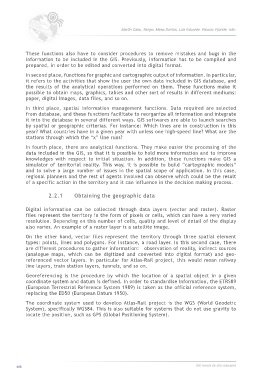Page 468 - 360.revista de Alta Velocidad - Nº 6
P. 468
Martín Cabo, Sergio. Mesa Santos, Luis Eduardo. Palacio Vijande, Iván.
These functions also have to consider procedures to remove mistakes and bugs in the
information to be included in the GIS. Previously, information has to be compiled and
prepared, in order to be edited and converted into digital format.
In second place, functions for graphic and cartographic output of information. In particular,
it refers to the activities that show the user the own data included in GIS database, and
the results of the analytical operations performed on them. These functions make it
possible to obtain maps, graphics, tables and other sort of results in different mediums:
paper, digital images, data files, and so on.
In third place, spatial information management functions. Data required are selected
from database, and these functions facilitate to reorganize all information and integrate
it into the database in several different ways. GIS softwares are able to launch searches
by spatial or geographic criterias. For instance: Which lines are in construction in this
year? What countries have in a given year with unless one high-speed line? What are the
stations through which the “x” line runs?
In fourth place, there are analytical functions. They make easier the processing of the
data included in the GIS, so that it is possible to hold more information and to improve
knowledges with respect to initial situation. In addition, these functions make GIS a
simulator of territorial reality. This way, it is possible to build “cartographic models”
and to solve a large number of issues in the spatial scope of application. In this case,
regional planners and the rest of agents involved can observe which could be the result
of a specific action in the territory and it can influence in the decision making process.
2.2.1 Obtaining the geographic data
Digital information can be collected through data layers (vector and raster). Raster
files represent the territory in the form of pixels or cells, which can have a very varied
resolution. Depending on this number of cells, quality and level of detail of the display
also varies. An example of a raster layer is a satellite image.
On the other hand, vector files represent the territory through three spatial element
types: points, lines and polygons. For instance, a road layer. In this second case, there
are different procedures to gather information: observation of reality, indirect sources
(analogue maps, which can be digitized and converted into digital format) and geo-
referenced vector layers. In particular for Atlas-Rail project, this would mean railway
line layers, train station layers, tunnels, and so on.
Georeferencing is the procedure by which the location of a spatial object in a given
coordinate system and datum is defined. In order to standardise information, the ETRS89
(European Terrestrial Reference System 1989) is taken as the official reference system,
replacing the ED50 (European Datum 1950).
The coordinate system used to develop Atlas-Rail project is the WGS (World Geodetic
System), specifically WGS84. This is also suitable for systems that do not use gravity to
locate the position, such as GPS (Global Positioning System).
466 360.revista de alta velocidad

